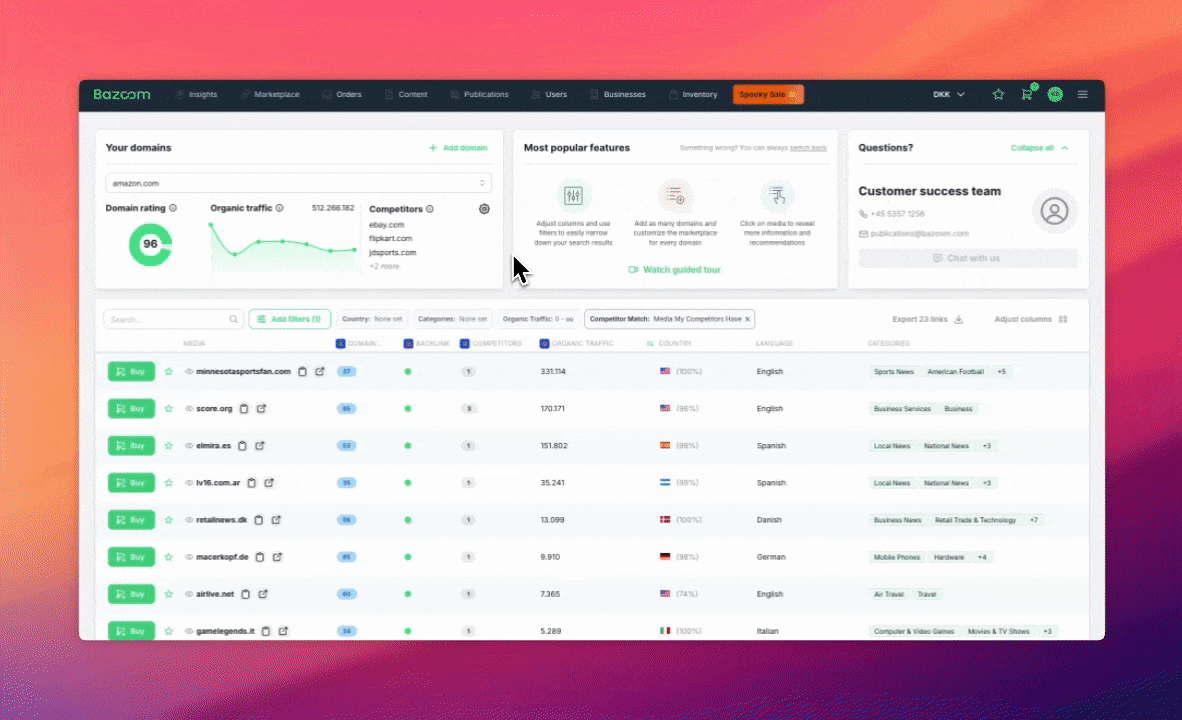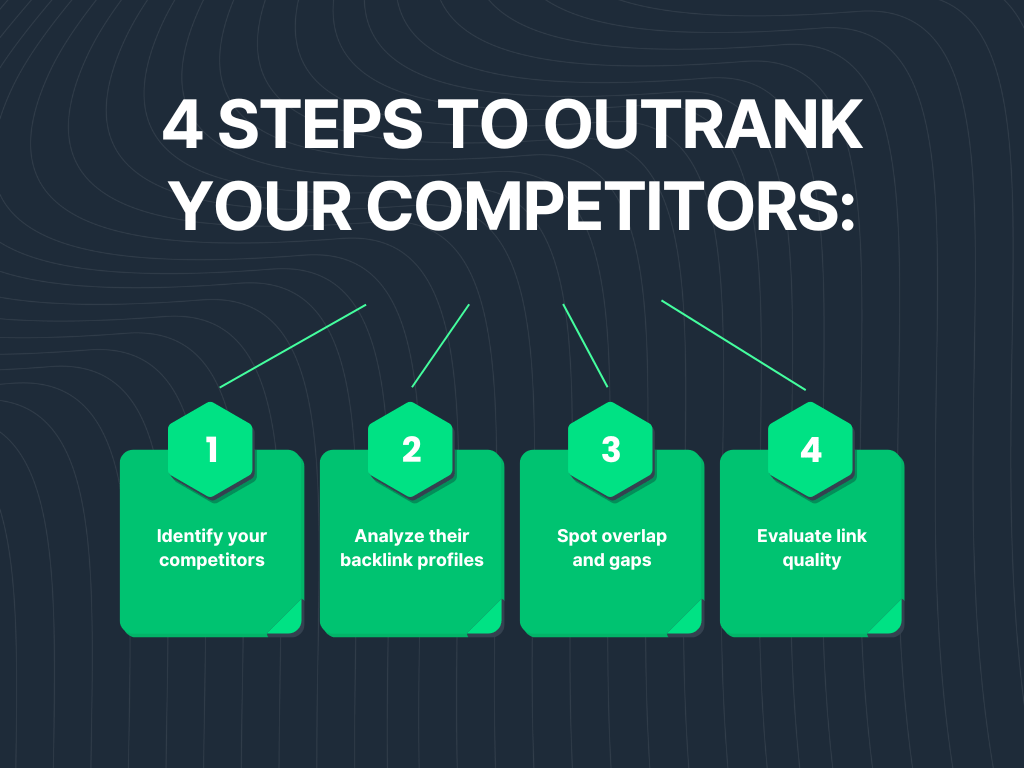Competitor backlink analysis: How to use it for your link building strategy

A competitor backlink analysis is one of the smartest strategies in link building.
By conducting a competitor link analysis, you keep a close eye on what your competitors are doing and gain valuable insights into which sites are linking to them, what’s working for them, and how you can replicate their success by analyzing their backlinks.
This is where competitor analysis comes in.
Understanding Competitor Backlink Analysis
Competitor backlink analysis is a crucial step in understanding your competitors’ link building strategies and identifying opportunities to improve your own website’s backlink profile.
By diving into your competitors’ backlinks, you can uncover valuable insights into their SEO tactics. This includes the types of websites that link to them, the anchor text used, and the overall quality of those links.
Such information is instrumental in refining your own link building strategy. Moreover, by identifying gaps in your competitors’ backlink profiles, you can exploit these opportunities to gain a competitive edge. This strategic approach not only helps in enhancing your backlink profile but also in boosting your search engine rankings.
Why competitor analysis matters in link building strategy
Competitor analysis involves researching the backlink profiles of your top competitors to understand their SEO strategy. Identifying competing domains is crucial in this process, as it helps you discover domains that rank for similar keywords, providing insights into the competitive landscape.
By doing this, you can:
- Discover link opportunities: Identify websites that are linking to your competitors and potentially reach out to them for your own link-building efforts.
- Understand their strategy: Are they focusing on guest posts, directory links, or partnerships with influencers? Knowing this can help you shape your own approach.
- Benchmark your progress: Tracking your competitors’ backlink growth allows you to see where you stand and what steps you need to take to improve.
Normally, you’ll need both a competitor analysis tool and a backlink checker, but at Bazoom, we’ve combined them into one platform.
Identifying Competitors and Keywords
Identifying your competitors and keywords is a crucial step in competitor backlink analysis. To start, you need to determine who your direct competitors are. Direct competitors are those offering similar products or services and targeting the same audience. Tools like Bazoom, Ahrefs and SEMrush can be invaluable in this process. They help you identify your competitors and their backlinks, giving you a clear picture of who you’re up against.
You can use tools like Ahrefs to export backlinks associated with a competitor’s URLs, which will help you analyze their link profile in detail.
Once you have a list of competitors, analyze their organic keywords. Divide these keywords into several categories to understand their link building strategy better. This categorization will reveal which keywords are driving traffic to their sites and where they are focusing their efforts. By understanding this, you can identify potential opportunities for your website and tailor your link building strategy accordingly.
Using Backlink Checker Tools
Backlink checker tools are indispensable for conducting a thorough competitor backlink analysis. These tools, such as Ahrefs, SEMrush, Bazoom (free), and Moz, allow you to delve deep into your competitors’ backlink profiles. They help you identify high-quality backlinks and filter out the poor-quality ones.

When using these tools, it’s essential to set filters that remove low-quality links, enabling you to focus on high-authority backlinks that can significantly benefit your website’s SEO efforts. By leveraging these tools effectively, you can gain a comprehensive understanding of your competitors’ backlink strategies and identify the best opportunities for your link building campaign.
How to conduct competitor backlink analysis
Here’s how you can analyze your competitors’ backlink profiles:

- Identify your competitors: List your direct competitors—the ones ranking for the same keywords. Tools like Ahrefs, SEMrush, and Moz can help you find out which websites are outranking you.
- Analyze their backlink profiles: Use an SEO tool to pull up a list of all their backlinks pointing to your competitors. Examine where these links are coming from, the content being linked to, and how authoritative the linking sites are. You can use a competitor’s URLs to gather backlink data effectively.
- Spot overlap and gaps: Compare their referring domains with yours. Are there high-quality sites linking to your competitors but not to you? These are opportunities you should pursue. Using Bazoom’s competitor backlink tool, you can easily enter your competitors and see which backlinks they have that you don’t—helping you spot gaps instantly and target those same sites.
- Evaluate link quality: Not all backlinks are equal. Prioritize the high-quality links your competitors have secured. These typically come from authoritative, relevant sites within your industry and will have the biggest impact on your rankings.
Evaluating Competitor Backlinks
Evaluating competitor backlinks involves a deep dive into the quality, quantity, and diversity of backlinks directing traffic to your competitors’ websites.
Start by using a backlink checker tool like Bazoom, Ahrefs or SEMrush to export your competitor’s backlink data.
This data will include information about the linking domains, anchor text, and page authority.
Analyze the linking domains to determine their relevance and authority. Look for high-authority domains that are relevant to your industry, as these will provide the most SEO value. Examine the anchor text to ensure it is relevant and not overly optimized, which can be a red flag for search engines.
Finally, check the page authority of the linking pages to gauge the quality of the backlinks. By focusing on high-value backlinks, you can identify the best opportunities to enhance your website’s SEO efforts.
Choosing the right sites based on competitor analysis
Once you’ve gathered your data, take action. Here’s how to choose the best sites for your own link-building strategy:
- Focus on relevance: Look for websites that are related to your niche. If your competitor is getting links from relevant sites, those are likely good targets for you too. Analyze the backlink profiles of domain-level competitors to identify unique linking domains that reference their websites.
- Prioritize High-Authority links: Links from strong domain authority sites will give your site more SEO value. Target sites that link to multiple competitors in your niche to enhance your link-building strategies and improve overall SEO performance.
- Reach out for guest posts or collaborations: If your competitors are securing links through guest posts or collaborations, reach out to those same sites with a pitch for your own fresh, valuable content.
Creating a Link Building Strategy
Creating a link building strategy involves leveraging the insights gained from competitor backlink analysis to build high-quality backlinks to your website. Start by identifying the types of content that are attracting links to your competitors’ websites. This could be blog posts, infographics, or resource pages. Create similar, high-quality content on your website to attract links.
Next, reach out to the linking domains identified in your competitor analysis. Craft personalized outreach emails highlighting the value of your content and why it would be a great addition to their site. Additionally, look for potential link building opportunities such as broken links, outdated content, or resource pages that can be updated with a link to your website. By strategically targeting these opportunities, you can build a robust link building strategy that drives results.
Hint: Use Bazoom’s free Link building “Strategy Builder”. Get a personalized strategy made by humans.
Turning Insights into Action
Conducting a competitor backlink analysis is just the first step. To turn insights into action, you need to use the data to inform your link building strategy. Start by identifying gaps in your competitors’ backlink profiles and targeting those opportunities.
Create content that not only matches but surpasses what your competitors offer. Additionally, reach out to sites that link to multiple competitors with a compelling pitch for your content.
By taking these proactive steps based on your competitor backlink analysis, you can enhance your website’s backlink profile and improve your search engine rankings. This strategic approach ensures that you are not just following but leading in your niche.
Outreach and Link Building Tactics
Outreach and link building tactics are essential for acquiring high-quality backlinks. Start by reaching out to potential linking domains via email or social media. Personalize your outreach emails to make a strong case for why your content is valuable and relevant to their audience.
Consider using various link building tactics such as guest blogging, where you contribute content to other websites in exchange for a backlink.
Resource pages are another great opportunity; these are pages that list valuable resources on a particular topic. If your content fits, request to be included.
Broken link building is another effective tactic—find broken links on relevant websites and suggest your content as a replacement. By employing these tactics, you can build a diverse and high-quality backlink profile.
Find the best place to buy backlinks. One that focuses on quality links, full transparency, and offers pay-per-link so you have full control.
Measuring Results and Refining Strategy
Measuring results and refining your strategy is crucial for the success of your link building campaign. Use tools like Ahrefs or SEMrush to track your backlink profile and monitor your website’s ranking. Regularly analyze the data to identify what’s working and what’s not.
Look at metrics such as the number of backlinks acquired, the quality of these backlinks, and the impact on your search engine rankings. Based on these insights, refine your strategy and adjust your outreach and link building tactics accordingly.
Remember to stay up-to-date with the latest link building trends and best practices to ensure your strategy remains effective. Regularly refreshing your research and adapting to changes in the SEO landscape will help you maintain a competitive edge.
Best Practices for Competitor Backlink Analysis
When conducting a competitor backlink analysis, there are several best practices to keep in mind. First, identify your direct competitors and thoroughly analyze their backlink profiles.
Use reliable backlink checker tools to gather comprehensive data on your competitors’ backlinks. Focus on identifying high-quality links and filter out the poor-quality ones. Use the insights gained to inform your link building strategy, targeting high-authority links that can boost your SEO efforts.
Finally, take actionable steps based on your analysis to improve your website’s backlink profile. By following these best practices, you can gain a competitive edge and significantly enhance your website’s search engine rankings.
Conclusion
Competitor analysis isn’t just about keeping up with your rivals—it’s about learning from their successes to build a smarter link-building strategy.
By studying your competitor’s backlinks, you can find new opportunities to boost your rankings.
Of course, keep your judgment in mind; not everyone knows what they are doing. Compiling all your data allows for a strategic overview of top-referring sites and valuable backlink opportunities. Sometimes, you’ll come across backlinks that don’t make sense—skip those and focus on the ones that suit your industry, niche, and metrics.se—skip those and focus on the ones that suit your industry, niche, and metrics.
One comment
Comments are closed.
[…] Aim to build a strong partnership. Backlink providers like Bazoom are interested in long-term commitments. And they will reward you with unbeatable rates, giving you the upper hand over your competitors. […]